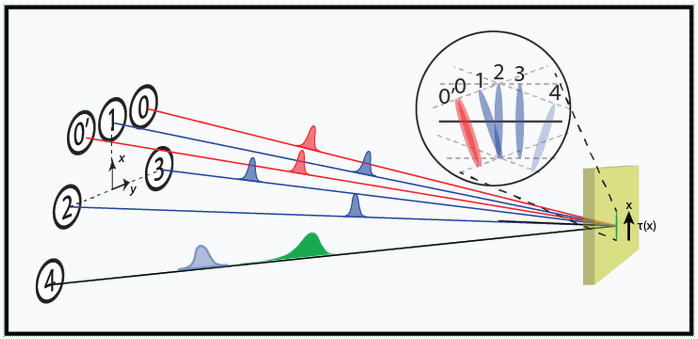Nonlinear Spectroscopy
The picture we give freshman students of molecules as a series of interconnected atoms is far from complete. Molecules have properties that extend far beyond their geometric structure, which enables them to participate in rich chemistries. The states of molecules may be described in terms of quantum mechanical degrees of freedom, whose correlations change during the course of a chemical reaction. Initial transformations of importance may occur on a sub-picosecond time scale and involve states of the system and its environment with vastly varying energies. Spectroscopy allows one to probe the time evolution of these states so as to reveal the underlying structure of molecules at a fundamental level. While many spectroscopic techniques exist, the ability to resolve these states and their intra- and intermolecular interactions becomes intractable for complex, multi-component systems. Following in the footsteps of nuclear magnetic resonance (NMR) spectroscopy, which has found enormous success in elucidating the structure of complex molecules in solution, multi-dimensional coherent spectroscopy (MDCS) holds the potential to reveal inter- and intramolecular couplings that are normally hidden in one-dimensional spectroscopic methods. Among its many advantages, MDCS is capable of resolving features obscured by inhomogeneous broadening that plagues lower-dimensionality methods such as transient-absorption spectroscopy. In addition, MDCS spreads the spectral content across two or more dimensions, providing inherently higher spectral resolution. Our group has made several contributions to advancing so-called third-order MDCS methods (i.e. 2D electronic spectroscopy), while also developing novel, higher-order methods (GAMERS):

GRAPES: In the 1970s, Richard Ernst and coworkers revolutionized NMR by recognizing that pulsed irradiation had a major advantage over continuous-wave (CW) methods because of multiplexing: the application of short RF pulses which cause all the nuclear spins within the pulse bandwidth to be excited simultaneously, thereby increasing the signal-to-noise (SNR). Pulsed NMR allowed for an endless variety of complex pulse sequences to be invented, which eventually lead to the discovery of the photon echo, MRI, etc… Our group has taken ideas from NMR, specifically multiplexing and space-to-time conversion in order to advance spectroscopic methods in the optical domain. Multiplexing in optics is particularly difficulty because oftentimes the optical transitions are spectrally broad and the light sources relatively narrow. For instance, a commercial femtosecond laser has a bandwidth that is only a fraction of the main S0->S1 transition of a prototypical dye molecule. Our lab has explored the use of self-phase modulation (SPM) to create white light, which is an octave spanning light source. The decreased stability of white light, however, presents a serious technical problem for methods that involve so-called indirect detection (i.e. sequential scanning followed by a Fourier transformation). To overcome this challenge, we have implemented an optical analog of a space-to-time conversion method introduced in NMR almost two decades ago which we call GRadient-Assisted Phonon Echo Spectroscopy or GRAPES. The main idea of GRAPES is to introduce a temporal gradient so as to simultaneously sample all the time delays of a two-dimensional pulse sequence. GRAPES has another major advantage: it completely eliminates noise caused by laser fluctuations, temperature gradients, etc… that make traditional point-by-point sampling methods notoriously difficult. Click here for additional details.
GAMERS: The correlations between different quantum-mechanical degrees of freedom of molecular species dictate their chemical and physical properties. Generally, these correlations are reflected in the optical response of the system but in low-order or low-dimensionality measurement the signals are highly averaged. Recently, our group has developed a novel four-dimensional coherent spectroscopic method that directly correlates within and between electronic and vibrational modes. We call this method Gradient-Assisted Multidimensional Electronic Raman Spectroscopy or GAMERS. GAMERS combines resonant and non-resonant excitation to select coherences on specific electronic states, thereby creating opportunities to directly distinguish coherent dynamics on the ground and electronically excited potentials. An exciting prospect for GAMERS is to study exciton-phonon interactions in nanoscale semi-conductors such as quantum dots. Another project involves mapping the vibrionic structure of photosynthetic pigment protein complexes, which is critical in understanding their role in the energy and charge transfer processes at the heart of photosynthesis. Click here for additional details.